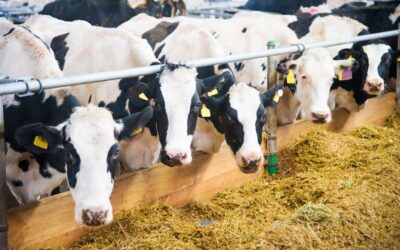Author: Marissa Vosburg
As the sustainability movement has grown and following the Paris Agreement and other climate legislation, many companies have found the benefit and the necessity in creating tangible goals to reduce their greenhouse gas (GHG) emissions. Dairy companies are not exempt from this trend as many have detailed goals to mitigate their environmental impact or reach carbon net zero.
As illustrated by the graphic, all the top 10 global dairy companies have stated emissions reduction goals. These goals range in time span from 2025 to 2050, with over half of these companies aiming to reach carbon net zero by or before 2050. Many also have intermediate goals at time points on the path to carbon net zero.
When creating emissions reduction targets, each firm must decide which scopes of emissions they want to target. Most often, scope 1 and scope 2 emissions are included as these refer to the direct greenhouse gases a company emits (scope 1) and the emissions from the electricity a company purchases (scope 2). Both scope 1 and scope 2 emissions are easier for companies to measure and control as they occur in-house or can be traced through purchase records.
However, a growing number of firms are also striving to reduce their scope 3 emissions. In fact, over half of the world’s 10 largest dairy companies have stated scope 3 emissions reduction targets.
By including scope 3 emissions in emissions reduction goals, dairy companies can better mitigate their environmental impact as 70%-90% of GHG emissions in the dairy industry are scope 3 emissions. Scope 3 emissions are indirect emissions that occur up- or downstream in the production process. In the case of the dairy industry, these emissions often occur in the production and transportation of raw milk. Because these emissions are not the direct results of processing facilities, they have traditionally been difficult to accurately measure with quality data, representing a significant problem for many dairy companies who rely on accurate figures to meet their climate targets.
Although scope 3 emissions have historically been challenging to measure and reduce, the current political and social climate necessitates investment in this area.
From a political perspective, California recently passed two bills to regulate emissions disclosures. California is one example of the growing trend to strengthen and broaden emissions disclosures to include scope 3 emissions, representing a growing political trend to increase the accuracy and impact of emissions disclosures. Measuring scope 3 emissions now allows firms to comply with relevant legislation and provides a time buffer to implement emission measuring programs before future emission disclosure legislation is passed.
Additionally, accurately measuring and reporting GHG emissions from all areas of the value chain, including scope 3 emissions, can mitigate greenwashing claims. Accusations of greenwashing pose significant risks to companies, but accurately tracking scope 1, 2, and 3 emissions provides evidence to counter any risks of greenwashing.
Further, accurately measuring scope 3 emissions creates added opportunities to reduce emissions. Given that the majority of GHG emissions for dairy companies are scope 3 emissions, finding levers to reduce these emissions creates more chances for firms to meet their stated emissions reduction targets.
However, reducing scope 3 emissions requires cooperation and collaboration with stakeholders throughout the value chain. In the case of dairy companies, this often requires direct work with producers to incentivize emissions reduction programs. Through this collaboration, processors gain access to high quality data and evidence-backed ingredients that decrease their overall environmental impact, thus allowing them to meet their emissions reduction goals.
Tracking scope 3 emissions and collaborating with producers to reduce them is especially relevant today as dairy companies near checkpoints on their paths towards carbon net zero and other emissions reduction targets. Fortunately, our team at Ever.Ag has the knowledge and on-farm experience to properly measure emissions upstream in processors’ value chains and suggest opportunities for emissions reduction. Through our model, producers are compensated for their contributions to reducing emissions while processors reap the benefits of decreased carbon emissions with the data to support their claims.


